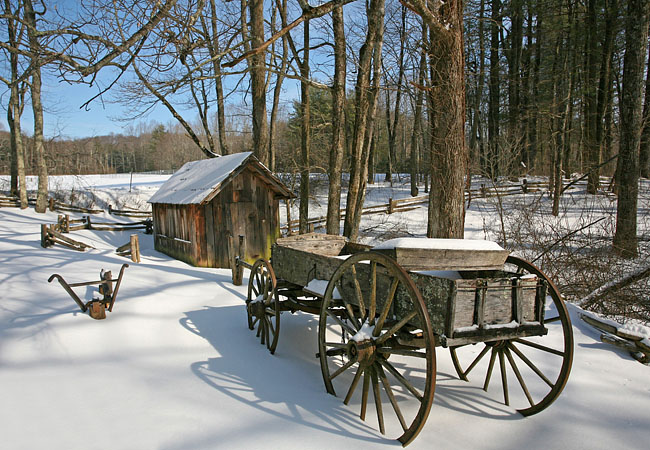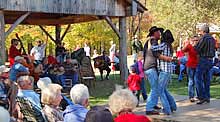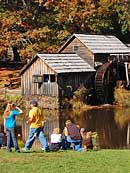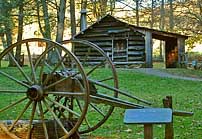|
Scenic USA - Virginia Mabry Homestead |

| Photo by Amanda Haddox Inset photos by Ben Prepelka |
The Blue Ridge Parkway, one of the longest scenic byways in the United States, is also a museum of early  pioneer homes and businesses. To some, the parkway is considered as a drive through time, where many rough-hewn log cabins, grist mills, sheds and barns help parkway visitors visualize life in the 18th and 19th century.
pioneer homes and businesses. To some, the parkway is considered as a drive through time, where many rough-hewn log cabins, grist mills, sheds and barns help parkway visitors visualize life in the 18th and 19th century.
Mabry Mill, one of the most popular parkway stops in Virginia, highlights the photogenic grist mill and its millrace, a blacksmith shop, sorghum mill, a one room cabin and bark mill. When first built in 1910 the water-powered grist mill was also utilized as a wheelwright shop and a sawmill. 
Born in Patrick County, Edwin Boston Mabry first worked as a blacksmith in the coal fields of West Virginia. Ed Mabry and wife Lizzie arrived in Floyd County in 1903, and soon conceived ideas of building a water-powered mill. Uncle Ed's well-rounded handyman skills would be essential to the surrounding community, as well as his resolve stay on the land and earn a living. It was customary for Ed and Lizzie to work a 12 hour day, grinding grain, sawing lumber, gardening, tending farm animals and creating one-of-a-kind items in his blacksmith shop. With the help of his friend, Newton Hylton, Mabry built a wooden overshot waterwheel and even created his own millstones from Brush Mountain rock.
During the early years in America, the village blacksmith was a key member of the community. The smithy's skills,  steadily improving for thousands of years, date back to 1500 BCE. Old World Hittites have been credited for being the first civilization to smelt iron and develop the processes of manipulating wrought iron. The American pioneer smithy, using a forge and anvil, possessed a broad range of metallurgical skills. With his knowledge the blacksmith could re-shoe a horse, repair a wagon wheel, build a gun barrel or axe, and was sometimes called upon to remedy a toothache, as he was the only one in town to have a pair of pliers.
steadily improving for thousands of years, date back to 1500 BCE. Old World Hittites have been credited for being the first civilization to smelt iron and develop the processes of manipulating wrought iron. The American pioneer smithy, using a forge and anvil, possessed a broad range of metallurgical skills. With his knowledge the blacksmith could re-shoe a horse, repair a wagon wheel, build a gun barrel or axe, and was sometimes called upon to remedy a toothache, as he was the only one in town to have a pair of pliers.
Area Map

|
More Area Attractions |
|
Copyright © 2024 Benjamin Prepelka
All Rights Reserved
